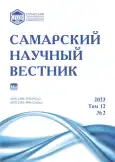The evaluation of effectiveness of preparations based on Steinernema carpocapsae (Nematoda: Rhabditida) against the greater wax moth (Galleria mellonella L.) and the yellow mealworm beetle (Tenebrio molitor L.)
- Authors: Chakina D.A.1, Rodionova E.Y.1
-
Affiliations:
- Kuban State University
- Issue: Vol 12, No 2 (2023)
- Pages: 98-101
- Section: Biological Sciences
- URL: https://journals.rcsi.science/2309-4370/article/view/253030
- DOI: https://doi.org/10.55355/snv2023122115
- ID: 253030
Cite item
Full Text
Abstract
At present, the issue of studying the effect of nematodes on insects has become one of the key issues, as biopreparations are a promising alternative to other chemical insecticides and expand the range of proposed means of protection. The use of biopreparations based on entomopathogenic nematodes is optimal because they do not have a negative impact on humans and the environment. In the course of the work we have identified the necessary concentration of biopreparation based on Steinernema carpocapsae, for an effective effect on the large wax moth and big flour borer. The study showed that the nematodes of St. carpocapsae species quickly penetrate and multiply in the body of the large wax moth. In the first day the biological effectiveness of the prepared suspension was 46,5% at a concentration of 1950 specimens/ml and 87% at a concentration of 3450 specimens/ml; while on the large wax moth the prepared suspension had a much slower effect. On the first day, the biological efficacy was only 24% at the two concentrations. Comparing the yield of nematodes, we found that for Galleria mellonella the concentration of 1950 specimens/ml was preferable, for Tenebrio molitor – 3450 specimens/ml.
Full Text
##article.viewOnOriginalSite##About the authors
Daria A. Chakina
Kuban State University
Email: dashok210chak@gmail.com
master student of Zoology Department
Russian Federation, KrasnodarElena Y. Rodionova
Kuban State University
Author for correspondence.
Email: rigaey@gmail.com
lecturer of Zoology Department.
Russian Federation, KrasnodarReferences
- Bradshaw C.J.A., Leroy B., Bellard C., Roiz D., Albert C., Fournier A., Barbet-Massin M., Salles J.-M., Simard F., Courchamp F. Massive yet grossly underestimated global costs of invasive insects // Nature Communications. 2016. Vol. 7. doi: 10.1038/ncomms12986.
- Пушня М.В., Снесарева Е.Г., Родионова Е.Ю., Балахнина И.В., Исмаилов В.Я. Использование новых штаммов вируса гранулеза для разработки эффективных средств борьбы с яблонной плодожоркой Сydia pomonella L. // Плодоводство и ягодоводство России. 2019. Т. 58. С. 172–179. doi: 10.31676/2073-4948-2019-58-172-179.
- Нещадим Н.Н., Пикушова Э.А., Веретельник Е.Ю., Горьковенко В.С. Интегрированная защита растений (зерновые культуры): учеб. пособие. Краснодар: КубГАУ, 2014. 278 с.
- Об органической продукции и о внесении изменений в отдельные законодательные акты Российской Федерации: Федеральный закон от 25.07.2018 № 280-ФЗ [Электронный ресурс] // Гарант.ру. https://base.garant.ru/ 72005268.
- Рябчинская Т.А., Бобрешова И.Ю., Каширских Ю.В., Мелькумова Е.А. К вопросу разработки нового биоцидного препарата на основе растительных компонентов // Вестник Воронежского государственного аграрного университета. 2021. Т. 14, № 2 (69). С. 57–70. DOI: 10.53914/ issn2071-2243_2021_2_57.
- Гришечкина С.Д. Механизмы действия и эффективность микробиологического препарата бацикола // Сельскохозяйственная биология. 2015. Т. 50, № 5. С. 685–693. doi: 10.15389/agrobiology.2015.5.685rus.
- Турицин В.С., Данилов Л.Г. Особенности экологии энтомопатогенных нематод семейства Steinernematidae (Nematoda: Rhabditida) // Вестник защиты растений. 2001. № 3. С. 23–29.
- Durieux M.-F., Melloul E., Jemel S., Roisin L., Darde M.-L., Guillot J., Dannaoui E., Botterel F. Galleria mellonella as a screening tool to study virulence factors of Aspergillus fumigatus // Virulence. 2021. Vol. 12, iss. 1. P. 818–834. doi: 10.1080/21505594.2021.1893945.
- Коновалова Т.В. Лабораторное содержание и разведение большой восковой огневки Galleria mellonella L. // Российский ветеринарный журнал. 2009. № 4. С. 46–48.
- Соколов В.В., Осокина А.С., Касаткин В.В. Технология механизации сортировки личинок Galleria mellonella L. // Вестник Казанского государственного аграрного университета. 2020. Т. 15, № 2 (58). С. 120–124. doi: 10.12737/2073-0462-2020-120-124.
- Чикин Ю.А., Гулик Е.С., Харлова А.А. Чувствительность личинок большого мучного хрущака Tenebrio molitor к Beauveria bassiana // Аграрная наука – сельскому хозяйству: сб. мат-лов XIV междунар. науч.-практ. конф. Кн. 1. Барнаул, 2019. С. 275–276.
- Данилов Л.Г. Особенности инвазирования и последующего развития нематод Neoaplectana carpocapsae штамм «agriotos» в насекомых при свободном контакте паразита с хозяином // Гельминты насекомых: сб. ст. / отв. ред. М.Д. Сонин. М.: Наука, 1980. С. 42–46.
- Методические указания по регистрационным испытаниям инсектицидов, акарицидов, моллюскоцидов и родентицидов в сельском хозяйстве / под ред. В.И. Долженко и др. СПб.: Всерос. науч.-исслед. ин-т защиты растений, 2004. 363 с.
- Abbott W.S. A method of computing the effectiveness of an insecticide // Journal of Economic Entomology. 1925. Vol. 18, iss. 2. P. 265–267. doi: 10.1093/jee/18.2.265a.
- Вейзер Я. Микробиологические методы борьбы с вредными насекомыми / пер. с чеш. М.П. Умнова; под ред. М.С. Гилярова. М.: Колос, 1972. 640 с.
Supplementary files






